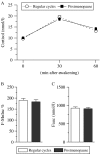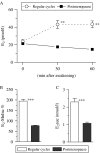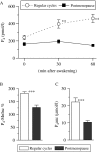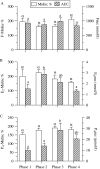Cortisol, estradiol-17β, and progesterone secretion within the first hour after awakening in women with regular menstrual cycles
- PMID: 21965547
- PMCID: PMC3209794
- DOI: 10.1530/JOE-11-0247
Cortisol, estradiol-17β, and progesterone secretion within the first hour after awakening in women with regular menstrual cycles
Abstract
Cortisol concentration in both serum and saliva sharply increases and reaches a peak within the first hour after waking in the morning. This phenomenon is known as the cortisol awakening response (CAR) and is used as an index of hypothalamus-pituitary-adrenal (HPA) axis function. We examined whether ovarian steroid concentrations increased after awakening as with the CAR in the HPA axis. To do this, cortisol, estradiol-17β (E(2)), and progesterone (P(4)) concentrations were determined in saliva samples collected immediately upon awakening and 30 and 60 min after awakening in women with regular menstrual cycles and postmenopausal women. We found that both E(2) and P(4) concentrations increased during the post-awakening period in women with regular menstrual cycles, but these phenomena were not seen in any postmenopausal women. The area under the E(2) and P(4) curve from the time interval immediately after awakening to 60 min after awakening (i.e. E(2)auc and P(4)auc) in women with regular menstrual cycles were greater than those in the postmenopausal women. E(2) and P(4) secretory activity during the post-awakening period was influenced by the phase of the menstrual cycle. E(2)auc in the peri-ovulatory phase and P(4)auc in the early to mid-luteal phase were greater than in the menstrual phase. Meanwhile, cortisol secretory activity during the post-awakening period was not influenced by menstrual status or the phase of menstrual cycle. These findings indicate that, as with the CAR in the HPA axis function, ovarian steroidogenic activity increased after awakening and is closely associated with menstrual status and phase of menstrual cycle.
Figures




Similar articles
-
Cortisol awakening response is blunted and pain perception is increased during menses in cyclic women.Psychoneuroendocrinology. 2017 Mar;77:158-164. doi: 10.1016/j.psyneuen.2016.12.011. Epub 2016 Dec 21. Psychoneuroendocrinology. 2017. PMID: 28064085
-
Effects of menstrual cycle phase and ovulation on the salivary cortisol awakening response.Psychoneuroendocrinology. 2024 Feb;160:106669. doi: 10.1016/j.psyneuen.2023.106669. Epub 2023 Nov 4. Psychoneuroendocrinology. 2024. PMID: 37988874
-
The cortisol awakening response (CAR) across the female menstrual cycle.Psychoneuroendocrinology. 2011 Jul;36(6):905-12. doi: 10.1016/j.psyneuen.2010.12.006. Epub 2011 Jan 14. Psychoneuroendocrinology. 2011. PMID: 21237574
-
HPA axis activity across the menstrual cycle - a systematic review and meta-analysis of longitudinal studies.Front Neuroendocrinol. 2022 Jul;66:100998. doi: 10.1016/j.yfrne.2022.100998. Epub 2022 May 18. Front Neuroendocrinol. 2022. PMID: 35597328
-
Circadian rhythms, sleep, and the menstrual cycle.Sleep Med. 2007 Sep;8(6):613-22. doi: 10.1016/j.sleep.2006.09.011. Epub 2007 Mar 26. Sleep Med. 2007. PMID: 17383933 Review.
Cited by
-
Effects of Sleep Fragmentation and Estradiol Decline on Cortisol in a Human Experimental Model of Menopause.J Clin Endocrinol Metab. 2023 Oct 18;108(11):e1347-e1357. doi: 10.1210/clinem/dgad285. J Clin Endocrinol Metab. 2023. PMID: 37207451 Free PMC article.
-
Emotion Dysregulation of Women with Premenstrual Syndrome.Sci Rep. 2016 Dec 6;6:38501. doi: 10.1038/srep38501. Sci Rep. 2016. PMID: 27922107 Free PMC article.
-
Association of salivary testosterone levels during the post-awakening period with age and symptoms suggestive of late-onset hypogonadism in men.Ann Med. 2024 Dec;56(1):2356667. doi: 10.1080/07853890.2024.2356667. Epub 2024 May 22. Ann Med. 2024. PMID: 38776237 Free PMC article.
-
Shift work and circadian dysregulation of reproduction.Front Endocrinol (Lausanne). 2013 Aug 7;4:92. doi: 10.3389/fendo.2013.00092. eCollection 2013. Front Endocrinol (Lausanne). 2013. PMID: 23966978 Free PMC article.
-
Oral Contraceptive Use and Prevalence of Self-Reported Glaucoma or Ocular Hypertension in the United States.Ophthalmology. 2016 Apr;123(4):729-36. doi: 10.1016/j.ophtha.2015.11.029. Epub 2016 Feb 11. Ophthalmology. 2016. PMID: 26948305 Free PMC article.
References
-
- van der Beek EM, Wiegant VM, van Oudheusden HJ, van der Donk HA, van den Hurk R, Buijs RM. Synaptic contacts between gonadotropin-releasing hormone-containing fibers and neurons in the suprachiasmatic nucleus and perichiasmatic area: an anatomical substrate for feedback regulation? Brain Research. 1997;755:101–111. doi: 10.1016/S0006-8993(97)00086-3. - DOI - PubMed
Publication types
MeSH terms
Substances
LinkOut - more resources
Full Text Sources

